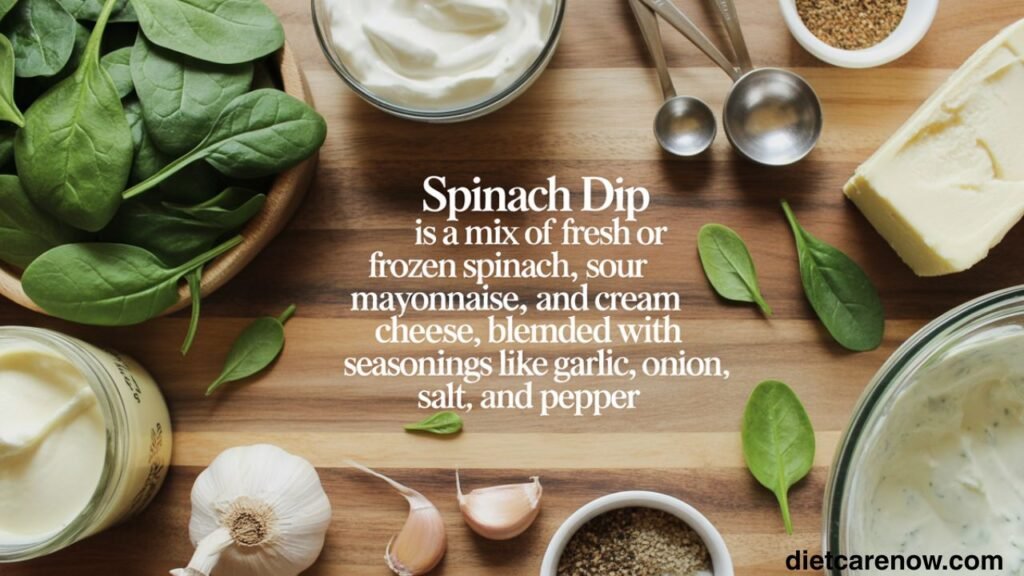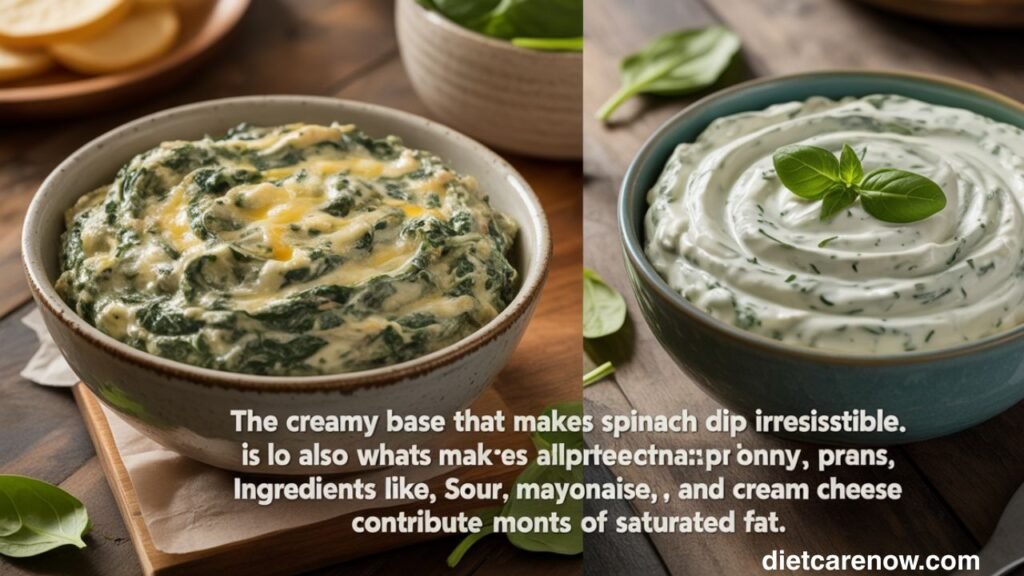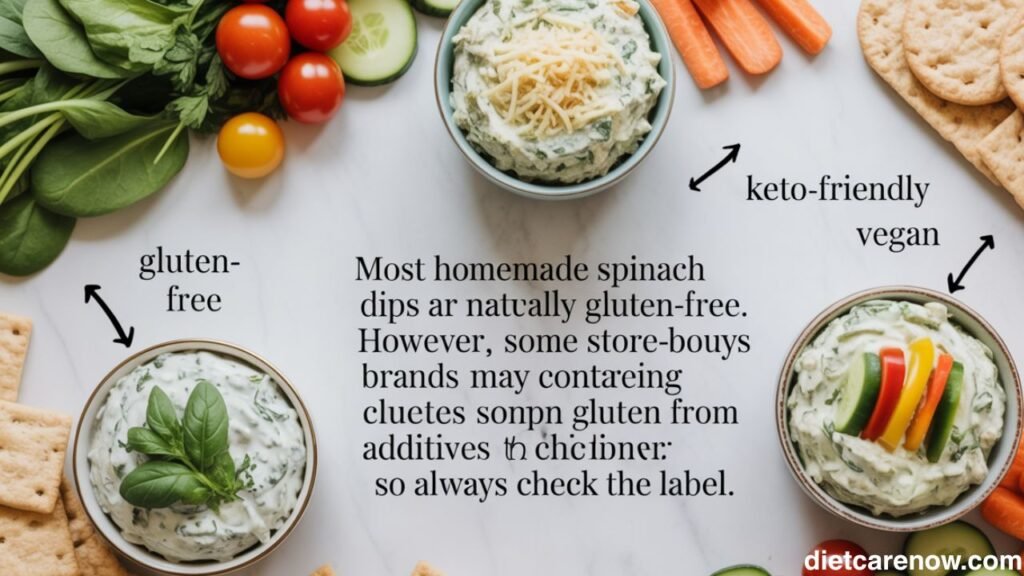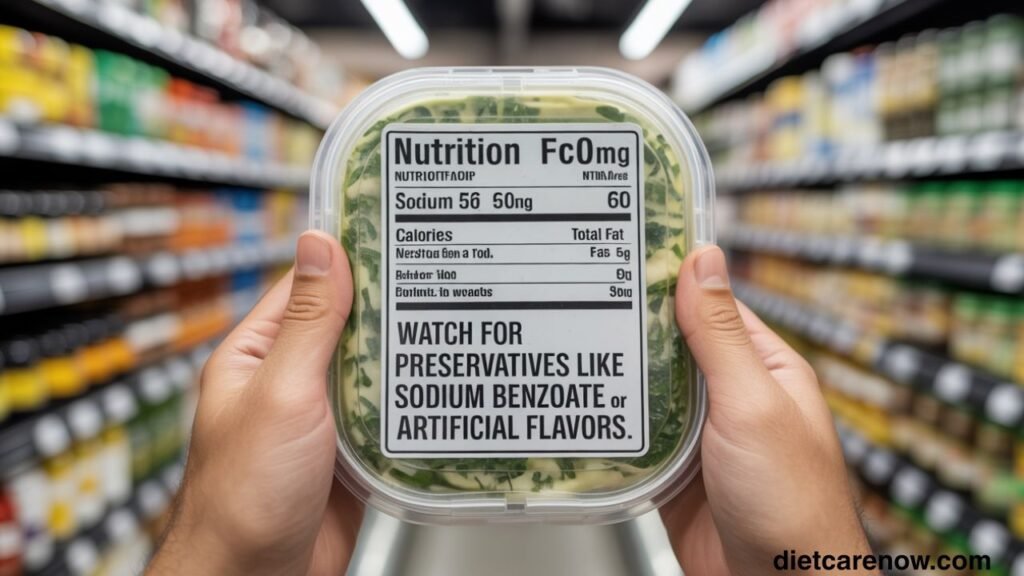Few appetizers bring people together like a creamy bowl of spinach dip. Whether it’s served warm with toasted bread or chilled with crisp vegetables, spinach dip is a timeless party favorite and comfort food. Its rich, savory flavor and smooth texture make it hard to resist.
Spinach dip has roots in American cuisine but draws inspiration from European dishes that blend greens with creamy bases. Over time, it’s evolved into countless variations — from the classic restaurant-style hot spinach and artichoke dip to lighter, yogurt-based versions served at home.
While spinach dip is often seen as an indulgence, understanding its nutrition helps you enjoy it more mindfully. Knowing what’s in it, how it affects your diet, and how to make it healthier can turn this creamy treat into a smarter choice rather than a guilty pleasure.
What Is Spinach Dip Made Of?
At its core, spinach dip is a mix of fresh or frozen spinach, sour cream, mayonnaise, and cream cheese, blended with seasonings like garlic, onion, salt, and pepper. Some recipes include shredded cheese — mozzarella, cheddar, or Parmesan — for extra richness.
Hot vs. Cold Spinach Dip
- Hot spinach dip is typically baked until bubbly and golden, giving it a rich, melted texture. It’s often served with bread, chips, or pita.
- Cold spinach dip, on the other hand, is chilled and creamy. It’s perfect for raw veggie platters or crackers and has a lighter, tangy flavor.
Homemade vs. Store-Bought
Homemade versions tend to be fresher and can be customized to suit dietary needs. Store-bought dips, while convenient, often contain preservatives, stabilizers, and more sodium. Understanding these ingredient differences plays a big role in how healthy your spinach dip really is.
Also read: /cell-nutrition/

Nutritional Profile of Spinach Dip
The nutritional value of spinach dip can vary depending on the recipe and portion size. On average, two tablespoons (about 30 grams) of spinach dip contain:
- Calories: 80–100
- Total Fat: 8 g
- Protein: 2 g
- Carbohydrates: 2 g
- Sodium: 150–250 mg
- Cholesterol: 10–20 mg
- Sugar: 1 g
If you eat more than a few spoonfuls — which most of us do — those numbers add up quickly. While spinach itself is low in calories, the creamy ingredients drive up fat and sodium levels. That’s why portion control is key.
Key Nutrients Found in Spinach Dip
Despite being a comfort food, spinach dip isn’t devoid of nutrition. It actually provides several essential vitamins and minerals, thanks to its core ingredients.
From Spinach:
- Vitamin A – supports eye health and immunity
- Vitamin K – important for bone health and blood clotting
- Folate – vital for cell growth and metabolism
- Iron – helps transport oxygen through the blood
From Dairy Ingredients:
- Protein – contributes to muscle repair and satiety
- Calcium – essential for strong bones and teeth
Other Nutrients:
Spinach also provides antioxidants like lutein and zeaxanthin, which protect against cellular damage, and dietary fiber, which supports digestion. While these benefits can’t cancel out high-fat content, they make spinach dip more than just empty calories.
Health Benefits of Spinach as the Main Ingredient
Spinach is a powerhouse green for a reason. Even in dip form, it adds a nutritional boost that makes this snack more worthwhile.
- Heart Health: Spinach is rich in nitrates that may help lower blood pressure and improve circulation.
- Digestion: Its fiber supports gut health and regularity.
- Immunity: Vitamins A and C enhance the body’s natural defenses.
- Anti-Inflammatory: Spinach contains compounds like flavonoids and carotenoids that reduce inflammation.
- Nutrient Density: Spinach provides a high concentration of nutrients for very few calories, making it one of the most nutrient-dense vegetables around.
Adding more spinach to your dip — and less cream — can help maximize these benefits.
The Hidden Calories: Fats and Creamy Ingredients
The creamy base that makes spinach dip irresistible is also what makes it calorie-dense. Ingredients like sour cream, mayonnaise, and cream cheese contribute significant amounts of saturated fat.
For example:
- 1 tablespoon of mayonnaise adds about 90 calories and 10 grams of fat.
- 2 tablespoons of cream cheese add roughly 100 calories and 9 grams of fat.
While fat isn’t inherently bad — it helps absorb vitamins and provides energy — too much saturated fat can raise LDL (bad) cholesterol and increase heart disease risk.
Ways to Make It Lighter:
- Swap Greek yogurt for sour cream or mayo.
- Use low-fat cream cheese or neufchâtel instead of regular.
- Add more spinach and herbs for volume and flavor.
Small tweaks like these can cut calories in half without losing that creamy appeal.

Store-Bought vs. Homemade Spinach Dip: Nutritional Comparison
When comparing store-bought to homemade spinach dip, the biggest nutritional differences are in sodium, freshness, and additives.
| Type | Calories (2 tbsp) | Sodium | Additives |
|---|---|---|---|
| Store-bought | 90–120 | 250–400 mg | Often includes preservatives and stabilizers |
| Homemade | 70–90 | 100–200 mg | Fresh ingredients, customizable |
Homemade dips give you full control over salt, fat, and flavor. You can choose lighter dairy products, increase spinach, or experiment with seasonings instead of extra salt. Store-bought dips are fine in moderation, but reading the label helps you make informed choices.
Low-Fat and Healthy Spinach Dip Alternatives
If you love spinach dip but want to keep things light, there are several simple swaps.
- Greek yogurt: Replaces sour cream for added protein and tang.
- Low-fat or plant-based cream cheese: Keeps the texture creamy with fewer calories.
- Cottage cheese: Blends smoothly and adds extra protein.
- Avocado or silken tofu: Great dairy-free bases that still feel rich.
- Flavor boosters: Garlic, lemon juice, dill, and cayenne can add depth without extra fat.
These adjustments keep the flavor while improving the nutritional balance — perfect for anyone watching their calorie intake.
How to Make a Nutritious Spinach Dip at Home
Here’s a healthier version that’s easy to whip up.
Ingredients:
- 2 cups chopped fresh spinach (or thawed frozen spinach, drained)
- 1 cup plain Greek yogurt
- ½ cup low-fat cream cheese
- ¼ cup grated Parmesan cheese
- 1 clove garlic, minced
- 1 teaspoon olive oil
- Salt and pepper to taste
Instructions:
- Sauté garlic in olive oil until fragrant.
- Add spinach and cook for 1–2 minutes until wilted.
- Mix in yogurt, cream cheese, and Parmesan until smooth.
- Season with salt and pepper.
- Serve warm or chilled with carrot sticks, cucumber slices, or whole-grain crackers.
Portion Control Tips:
- Stick to 2–3 tablespoons per serving.
- Pair it with fiber-rich dippers to stay full longer.
- Serve it in smaller bowls to encourage moderation.
Common Dietary Considerations
Is It Gluten-Free?
Most homemade spinach dips are naturally gluten-free. However, some store-bought brands may contain gluten from additives or thickeners, so always check the label.
Keto and Low-Carb Diets
Spinach dip can fit into keto diets because it’s high in fat and low in carbs — just watch portion sizes and use low-carb dippers like celery or cucumber.
Lactose-Free and Vegan Versions
For lactose-intolerant or vegan eaters, substitute with plant-based yogurts and cheeses made from almond, cashew, or soy. The flavor and texture can still be deliciously creamy.

How Spinach Dip Fits Into a Balanced Diet
No single food determines whether a diet is healthy or not — it’s all about balance. Spinach dip can absolutely have a place in your meal plan if you keep portions in check.
- Use it as a side or snack, not a main meal.
- Pair it with fresh veggies instead of chips.
- If you’re tracking calories, consider it an occasional treat rather than a daily staple.
By being mindful, you can enjoy the flavor without overdoing it.
Spinach Dip and Weight Management
Is spinach dip good for weight loss? It depends on how it’s made and how much you eat.
Traditional versions are high in calories and fat, which can slow weight loss if eaten in large amounts. However, lighter recipes using Greek yogurt or cottage cheese can fit well into a calorie-conscious diet.
Because spinach dip is flavorful and satisfying, it can actually help prevent overeating by curbing cravings — as long as you watch your portions.
Reading Nutrition Labels on Store-Bought Spinach Dip
If you buy spinach dip from the store, take a moment to read the label carefully.
What to Check:
- Sodium: Some brands pack over 400 mg per serving.
- Additives: Watch for preservatives like sodium benzoate or artificial flavors.
- Serving sizes: Many labels list unrealistically small servings (2 tbsp), which can make calories appear lower than they are.

Expert Tips for Enhancing Nutrition Without Losing Flavor
Dietitians often recommend focusing on flavor from fresh ingredients instead of fat or salt. Here are some expert-approved ideas:
- Add extra veggies like chopped artichokes, kale, or roasted red peppers.
- Use herbs such as dill, parsley, or basil for freshness.
- Brighten the flavor with lemon zest or vinegar instead of extra cheese.
- Experiment with texture — try mixing in finely chopped nuts or seeds for crunch.
- Serve with colorful crudités to boost fiber and vitamins while cutting calories.
These small upgrades make a big difference in both nutrition and enjoyment.
Conclusion: Making Spinach Dip a Smarter Choice
Spinach dip doesn’t have to be off-limits. When made thoughtfully, it can offer both comfort and nutrition in one creamy scoop.
The key is balance — understanding what’s in your dip, watching portion sizes, and making simple swaps for lighter ingredients. Homemade versions allow you to control sodium, fat, and flavor while keeping the wholesome goodness of spinach intact.
So go ahead, enjoy your spinach dip. Just make it smarter: add more greens, use fresh dairy or plant-based alternatives, and serve it alongside foods that nourish you. With a few mindful choices, this crowd-pleasing favorite can easily fit into a healthy, satisfying diet.

